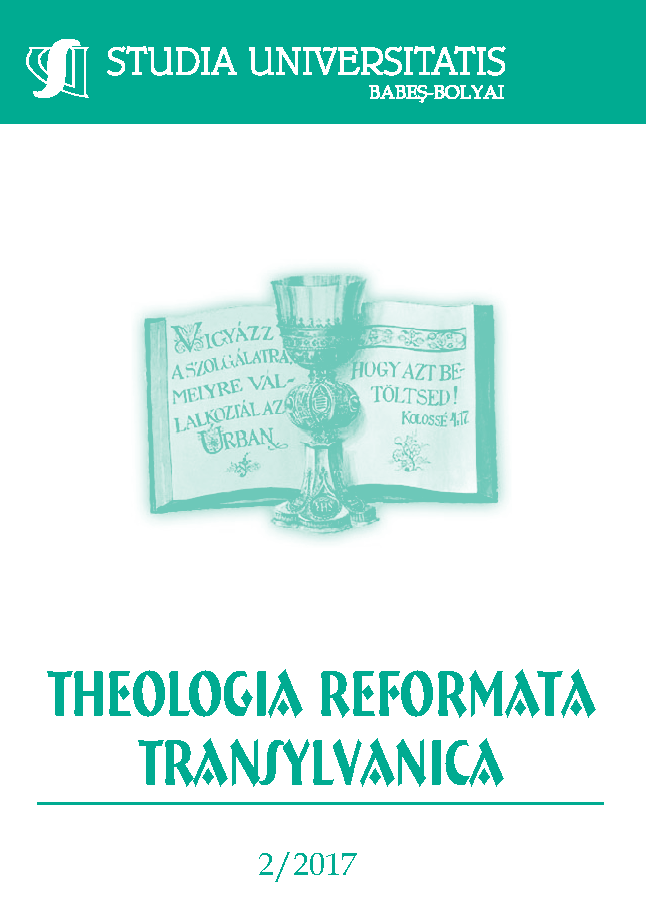Az egyháztörténet tanításának jelentősége és módja
DOI:
https://doi.org/10.24193/subbtref.62.2.06Keywords:
church history, teaching, Calvinism, paragon, longitudinal and cross section.Abstract
Significance and ways of teaching Church history.
Church history brings up pictures from the past in order to help win in the present, so „to make ready a people prepared for the Lord” (Luk 1,17). Keeping that in mind we can teach Church history in a,) linear time surveys b.) point-like stories of paragons c.) value orientations d.) pointing on to the mystery of the church. Surveys are proper for youth and adults, episodes and examples on life-values can be used even with small children. Difficulties: our prejudice that teaching Church history is difficult; lack of sources partly due to the battle-filled past of the Hungarian Reformed Church; much reading is required in order to find proper stories not only data; one must use more than one resource for self-control. Ways of teaching: We can begin „in medias res” with a special interesting story from the person’s life to be introduced, asking: who was it?; we can raise questions around a known information. We can use these old stories as illustrations on the truth of a Biblical text. We can analyze sources. Using visual aid is vital. Polemic discussions are also good to keep attention awake. Any way we choose, we must teach enthusiastically, in an adventure-like spirit, not in a boring way. Church history is part of our identity. The article gives some illustrations on these statements.
References
BOROSS Géza: Bevezetés a valláspedagógiába. Károli Gáspár Református Egyetem Hit-tudományi Kar, Budapest, 1996.
DÉZSI Lajos: Szenczi Molnár Albert. Magyar Történeti Társulat kiadása, Bp., 1897. http://mek.oszk.hu/05600/05617/html/
FÉJA Géza: Szenczi Molnár Albert emlékezete. Kortárs. Irodalmi és kritikai folyóirat. 1974. aug. XVIII. évf., 8.
HORN Ildikó: Lorántffy Kata. In: Tamás Edit (szerk.): Erdély és Patak fejedelem-asszonya Lorántffy Zsuzsanna. I. Tanulmányok születésének 400. évfordulójára. Nemzeti Kulturális Örökség kiad., Sárospatak, 2000.
KÁROLYI Gáspár: Két könyv. Debrecen, 1563. http://mek.niif.hu/05200/05236/html/karolyi_gonci0001/karolyi_gonci0001.html 2017. november 01. 11.11h
KENYERES Ágnes (főszerk.): Magyar Életrajzi Lexikon 1000-1990 (digitális változat). Rákóczi György címszó. http://mek.oszk.hu/00300/00355/html/index.html 2017. október 21. 14.45h
MAKKAI Sándor: Egyháztörténelem a népiskolában. Az ÚT, 1916. 46
PÉTER Katalin: Milyenek voltak az erdélyi fejedelemasszonyok? In: Péter Katalin – Tamás Edit: Lorántffy Zsuzsanna album. Sárospataki Rákóczi Múzeum Füzetei, Sárospatak, 2000.
PRUZSINSZKY Pál: Kálvin János életrajz a reformátor születésének négyszázados évfordulója alkalmából. A Magyar Református Egyház Kiadása, Pápa, 1909.
RÉVÉSZ Imre: Történelmi ideálok. Diákvilág, 1916. VIII. évf. 3-4. november-december
SZABÓ András: Bizontalan helyeken búdosunk. Lilium Aurum, Selye János Egyetem Tanárképző Kar, Dunaszerdahely-Komárom, 2011.
SZILÁGYI Sándor: Lorántfy Zsuzsánna. Történeti család- és jellemrajz. A Magyar Tudományos Akadémia évkönyvei XIII. kötetének 9. darabja. Pest, 1872.
SZILÁGYI Sándor: Magyar történeti életrajzok. Felső-vadászi Rákóczy Zsigmond, 1622–1652. A Magyar Tudományos Akadémia és Magyar Történelmi Társulat megbízásából szerk.: Szilágyi Sándor. Méhner Vilmos kiad., Franklin-Társulat Könyvnyomdája, Budapest, 1886. MEK http://mek.oszk.hu/05700/05707/html/
ZOVÁNYI Jenő: Magyarországi Protestáns Egyháztörténeti Lexikon. 3. kiad., Szerkesztette: Ladányi Sándor. Magyarországi Ref. Egyház Zsinati Irodájának Sajtóosztálya, Budapest, 1977.
Downloads
Published
How to Cite
Issue
Section
License
Copyright (c) 2017 Studia Universitatis Babeș-Bolyai Theologia Reformata Transylvanica

This work is licensed under a Creative Commons Attribution-NonCommercial-NoDerivatives 4.0 International License.






